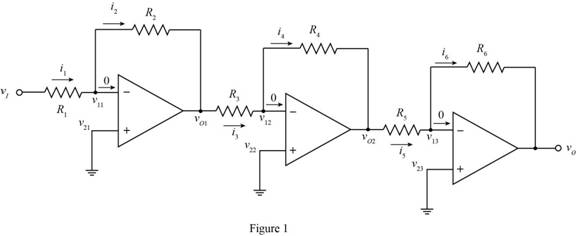
Concept explainers
Design an amplifier system with three inverting op-amps circuits in cascadesuch that the overall closed-loop voltage gain is
The design parameters for an inverting op-amp circuit.
Answer to Problem D9.18P
The value of the resistance
Explanation of Solution
Calculation:
The required diagram for the inverting op amp with feedback is shown below.
The required diagram is shown in Figure 1.

The expression for the value of the voltage
Substitute
The expression for the voltage
Substitute
The expression for the value of the voltage
Substitute
The expression for the output voltage of the first op-amp is given by,
The expression for the second voltage of the first op amp is given by,
Substitute
The expression for the voltage gain is given by,
Substitute
Apply KCL at the negative terminal of the right most op-amp.
Substitute
Substitute
Substitute
The expression for the value of the current
Substitute
The expression for the value off the voltage
Substitute
The expression for the value of the current
Substitute
The expression to determine the range of the current is given by,
Substitute
The expression for the value of the mid stage gain is given by,
Substitute
The expression for the minimum value of the resistance
Substitute
The maximum value of the resistance
The expression for the value of the resistance
Substitute
The expression for the gain of the voltage gain of right most amplifier is given by,
Substitute
The value for the current
The expression for the value of the resistance
Substitute
The expression for the maximum value of the resistance
Substitute
Conclusion:
Therefore, the value of the resistance
Want to see more full solutions like this?
Chapter 9 Solutions
Microelectronics: Circuit Analysis and Design
 Introductory Circuit Analysis (13th Edition)Electrical EngineeringISBN:9780133923605Author:Robert L. BoylestadPublisher:PEARSON
Introductory Circuit Analysis (13th Edition)Electrical EngineeringISBN:9780133923605Author:Robert L. BoylestadPublisher:PEARSON Delmar's Standard Textbook Of ElectricityElectrical EngineeringISBN:9781337900348Author:Stephen L. HermanPublisher:Cengage Learning
Delmar's Standard Textbook Of ElectricityElectrical EngineeringISBN:9781337900348Author:Stephen L. HermanPublisher:Cengage Learning Programmable Logic ControllersElectrical EngineeringISBN:9780073373843Author:Frank D. PetruzellaPublisher:McGraw-Hill Education
Programmable Logic ControllersElectrical EngineeringISBN:9780073373843Author:Frank D. PetruzellaPublisher:McGraw-Hill Education Fundamentals of Electric CircuitsElectrical EngineeringISBN:9780078028229Author:Charles K Alexander, Matthew SadikuPublisher:McGraw-Hill Education
Fundamentals of Electric CircuitsElectrical EngineeringISBN:9780078028229Author:Charles K Alexander, Matthew SadikuPublisher:McGraw-Hill Education Electric Circuits. (11th Edition)Electrical EngineeringISBN:9780134746968Author:James W. Nilsson, Susan RiedelPublisher:PEARSON
Electric Circuits. (11th Edition)Electrical EngineeringISBN:9780134746968Author:James W. Nilsson, Susan RiedelPublisher:PEARSON Engineering ElectromagneticsElectrical EngineeringISBN:9780078028151Author:Hayt, William H. (william Hart), Jr, BUCK, John A.Publisher:Mcgraw-hill Education,
Engineering ElectromagneticsElectrical EngineeringISBN:9780078028151Author:Hayt, William H. (william Hart), Jr, BUCK, John A.Publisher:Mcgraw-hill Education,





